A ripping tale in which Dani refuses to play by Professor X's-- and by extension, Claremont's-- rules.
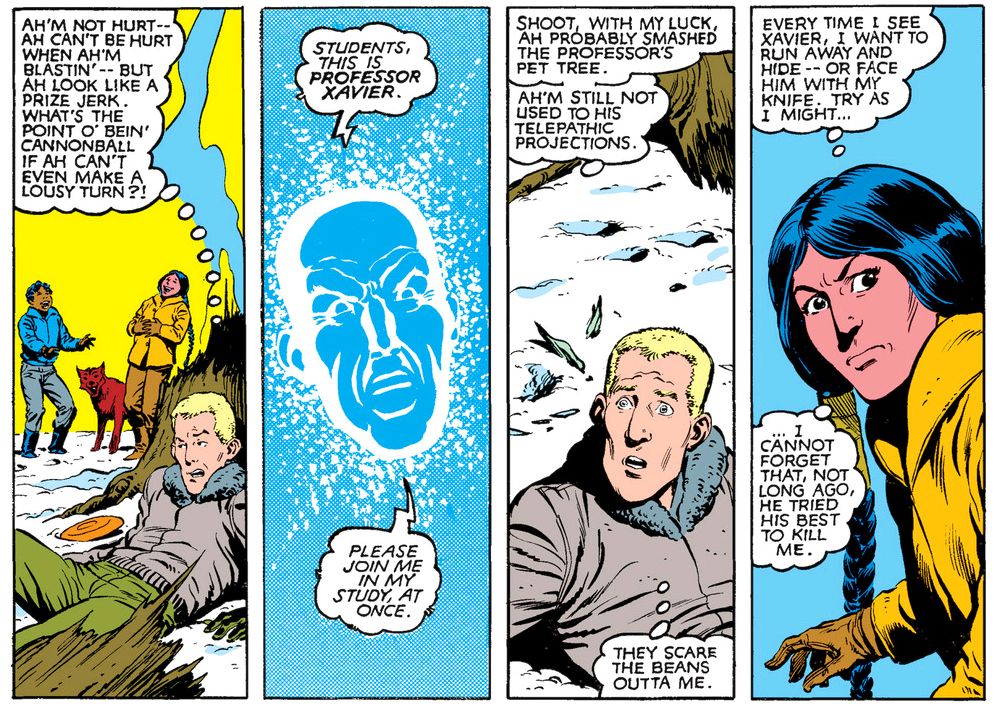 |
| Chris Claremont, script/Sal Buscema and Bob McLeod, art (New Mutants #4, June 1983) |
The Brood are Claremont's homage to Ridley Scott's nightmare-inducing Geiger-designed "xenomorph" from the film Alien (this was before James Cameron's expansion of the idea in Aliens and way before the travesty of the later sequels and dimbulb involvement with the Predator franchise). Claremont and co-plotter/artist John Byrne had already relied heavily on Alien for a Kitty Pryde story in Uncanny X-Men #143 (March 1981) and like all the greats, they knew to steal from the best. When the xeno-Brood inside Professor X failed to drive Dani insane or turn her into a host for its spoor, Claremont turned to a completely new storyline, one that promised to take the book in a more earthbound direction. In The New Mutants #4 (June 1983), Dani and the rest tackle a more mundane menace. Someone is stalking their dance teacher, Stevie Hunter.
I remember excitedly reading "Who's Scaring Stevie?"* in study hall at good ol' Albany Junior High and hoping Claremont and company were taking the book in a less superheroic direction, one that would see the team using their powers less and dealing with teen concerns and social issues more. Or investigating haunted houses and breaking up smuggling rings dealing in old pirate gold a la Nancy Drew and the Hardy Boys. With the older, more powerful X-Men back, I didn't see any reason why a bunch of kids my age needed to fight aliens or save the world when there were so many smaller threats around few comics at the time addressed but were the central stuff of many S.E. Hinton and Judy Blume books-- not to forget J.D. Salinger, William Golding or even Anthony Burgess, for pretention's sake. As a junior high schooler with "outsider" status much like the New Mutants themselves (largely caused by reading comic books in study hall), I wanted stories that used the superheroic genre to comment directly on real-life concerns of the kinds my friends and I dealt with every day.
Years later, I'd write a letter to Image asking that they do something similar with Gen13 (why waste a chance to explore the dichotomy between being a super-being and a party-crazed college student by blatantly rehashing The New Mutants plots?) and they nicely told me to keep my stupid ideas to myself.
In setting up this story, Claremont tries valiantly to re-establish The New Mutants as an ensemble piece. Gone are the extended solo Dani sequences as Claremont and new penciller Sal Buscema reduce her "screen" time and plump up the roles of Roberto, Sam, the Other One and Whatsherface. After a playful romp in the snow where Dani treats poor, naive Rahne like a canine pet and Sam once again displays his winning propensity for spectacular power failures, the kids have to report to Professor X for a heart-to-heart.
 |
| Claremont, Buscema, McLeod (New Mutants #4, June 1983) |
But Claremont can't help giving rebellious Dani the best lines and most memorable moments. On the way to the Professor's study, Dani refuses to back down-- giving Claremont a chance to use some of his classic arch dialogue to make Dani sound more like Scott "Cyclops" Summers or one of Sgt. Fury's Howling Commandos than any teen we've ever encountered, fictional or real-- from Lilandra, the pointy-headed empress of a vast space empire. That's right. Dani sasses a SPACE EMPRESS, which earns her Lilandra's (and this reader's) admiration in the process. As a follow-up, Dani then presumes to speak for the entire team without even taking a moment to do something democratic like listen to their opinions. Buscema and inker Bob McLeod give Professor X a brilliant close-up panel where the look on his face registers sheer horror and dismay at Dani's obvious power play. The world's most powerful psychic is scared shitless of this pig-tailed girl and her red t-shirt.
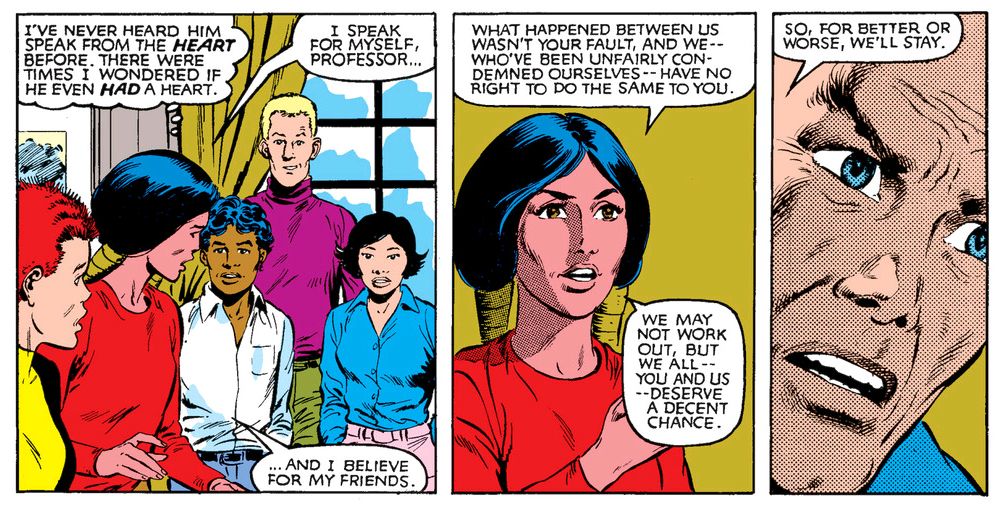 |
| Claremont, Buscema, McLeod (New Mutants #4, June 1983) |
And while Xi'an does her expository best to get the plot rolling, Dani has other ideas-- she turns this scene into a moratorium on Professor X's leadership which ends with the poor exasperated guy practically begging her to stop making his life miserable and get with the program, please.
 |
| Claremont, Buscema, McLeod (New Mutants #4, June 1983) |
While the rest of the story is given over to the team as a whole investigating Stevie's stalker, it's Dani who makes the strongest impact. Again. She won't shut up, won't back down, won't take guff from anyone. Oh yeah, and when they find the kid, it's Dani who reduces him to a sniveling wreck by blasting the shit out of him with her powers. She tells Xi'an she can't help it, but we suspect the real reason is she's taking out her frustration at not getting the center spot on this issue's cover or a double-page spread all her own where she interacts with squirrels and chipmunks while plotting Professor X's ultimate downfall and renaming his school Danielle Moonstar's Academy of Ass-Kicking.
Then my hoped-for emphasis on well-meaning kids solving their peers' social issues turned into a Saturday morning TV commercial for Ideal Toys. I'm not sure how this happened-- it smacks of editorial interference in an attempt to create synergy for a licensed product-- but in The New Mutants #5 (July1983), the team suddenly finds itself involved with Team America. Not those delightfully profane marionettes who savaged both Bush-era jingoism and Hollywood liberalism in equal measures but the motorcycle riding dullards you could buy at K-Mart if you didn't have the simple human decency to collect G.I. Joe.
Incredibly, this spins itself into a two-issue tussle with Hydra and, even more nonsensically, the Silver Samurai where even Claremont can't generate enough enthusiasm to do more than phone in the rotest of rote plots. Yes, Hydra had its glory moments in quite a few stories, but here their involvement smacks of "Well, we need some bad-guys and Hydra doesn't take much effort: they're always doing crazy world-domination shit." And what the heck does Hydra have to do with the New Mutants anyway? Then there's the art. Oh brother, the art!
In this era, most pencillers didn't do the completely finished drawings they do these days and inkers usually played a more important role in maintaining a book's consistent look. If a penciller felt concerned about how an inker might interpret the pages, then he or she might render things more completely, or "tightly." But these tight pencils took time and time was something many of these deadline-oriented books could not spare. Some pencillers would simply do layouts, which were just roughly blocked-in panels with figures in outline or quickly sketched; these could go either to another penciller for clean-up and finish and then to an inker, or simply to an inker. Masters like John Buscema drew loosely and it was up to the inkers to clean things up and actually draw in ink.
Bob McLeod is one of those inkers who flat-out knows how to draw. On The New Mutants, if I'm remembering what he told us on Facebook correctly, McLeod was knocking himself out with tight pencils to try to control the book's look (after all, he co-created these characters), but couldn't maintain the brutal pace and keep up the quality. So they brought in John's brother Sal Buscema because he could provide clean-reading pages for McLeod to work over. It worked beautifully in The New Mutants #4, which looks more or less like a McLeod solo job. But what happened here? Armando Gil excelled at inking Michael Golden on The 'Nam, but he and Buscema are a lethal mix. The art in the book's latter stages is as ugly and slapdash as its plot.
Anyway, Team America. Oh, they turn out to be mutants. How convenient! This half-assed connection is enough for the kids to get themselves entangled with these motorcycle stunt riders (led by a guy with the admittedly awesome name R.U. Reddy). And it's here where Dani begins to take things into her own hands.
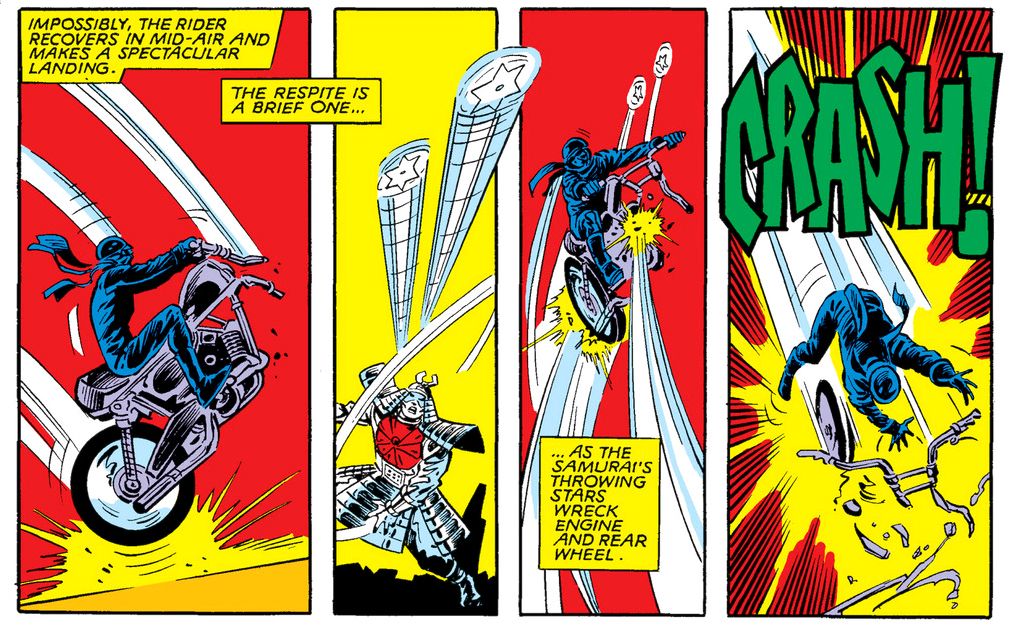 |
| Claremont, Buscema, and probably Armando Gil (New Mutants #5, July 1983) |
Some fictional characters take on a life of their own. Their mass within the plot tends to deform narratives much in the way gravity bends lightwaves. At this point, with Claremont seemingly phoning in these issues and the art going wonky, Dani makes her move. Whose headstrong nature finds her kidnapped and dressed in a green catsuit? Who is the vessel for the manifestation of Team America's gestalt mutant power and gets to tear-ass around on a dirtbike as the Dark Rider? Of course it's Sam Guth-- no.
Dani Moonstar.
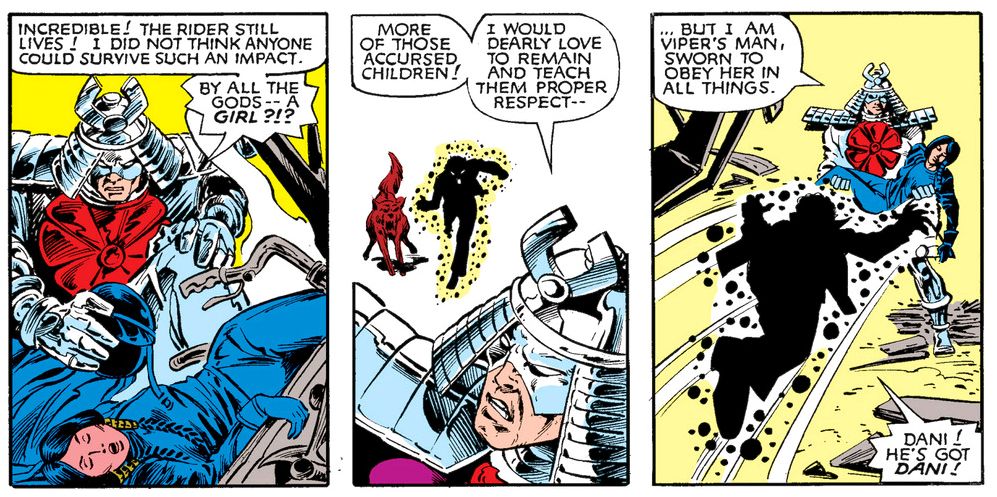 |
| Claremont, Buscema, probably Gil (New Mutants #5, July 1983) |
As we've seen through five issues, anything interesting is happening in any given The New Mutants, it's happening to Dani. Well, until Xi'an finally gets a storyline in #6 (August 1983). But even that is mostly an excuse to bump her off so Dani can assume leadership of the team. Claremont hedges his bets by having her share the honors with Sam, but we all know who's the weaker in their partnership. There's no way Sam's good-natured country boy manner can stand up against Dani's hotheaded ways.
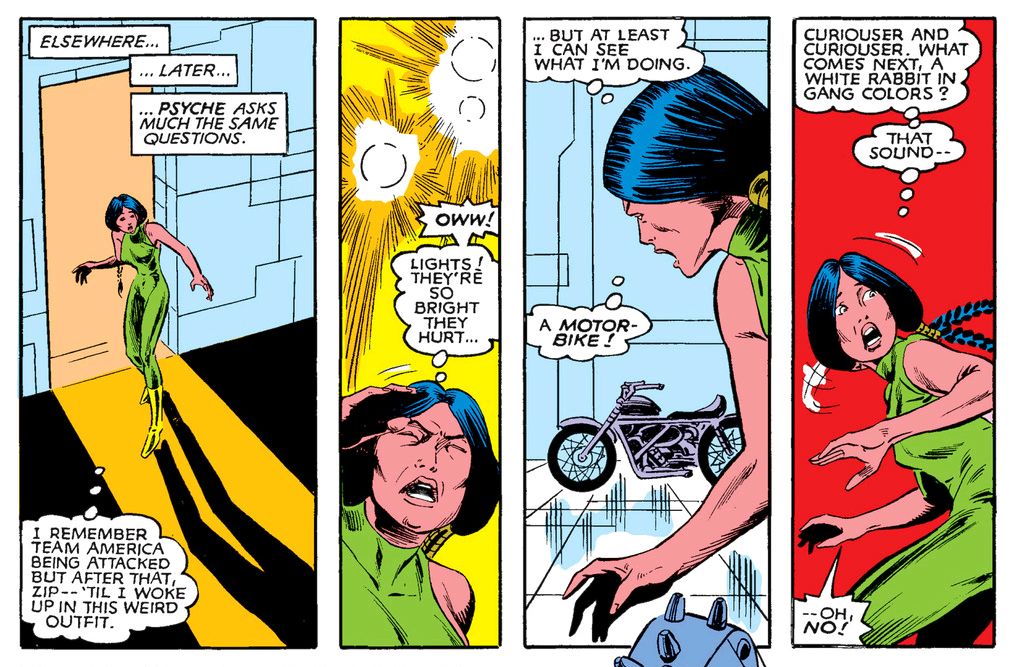 |
| Claremont, Buscema, definitely Armando Gil (New Mutants #5, July 1983) |
Notice, too, that even though they're ostensibly mourning the loss of Xi'an, the true reason for the kids' detour to Rio de Janeiro in The New Mutants #7 (September 1983) is so Dani can indulge herself in the wearing of a skimpy Carnival outfit. I've already written at length about Dani's clothing-optional lifestyle so I won't go into that here. Suffice it to say, Dani is at home in her skin and thinks nothing of flaunting it.
And why not? She's Dani Moonstar, for cripes' sake! She's defeated the Hellfire Club, Professor X, the Brood, Hydra and Chris Claremont.
Soon, however, she would face her greatest challenge.
*The answer to that question-- if you care-- is Peter Bristow.

No comments:
Post a Comment